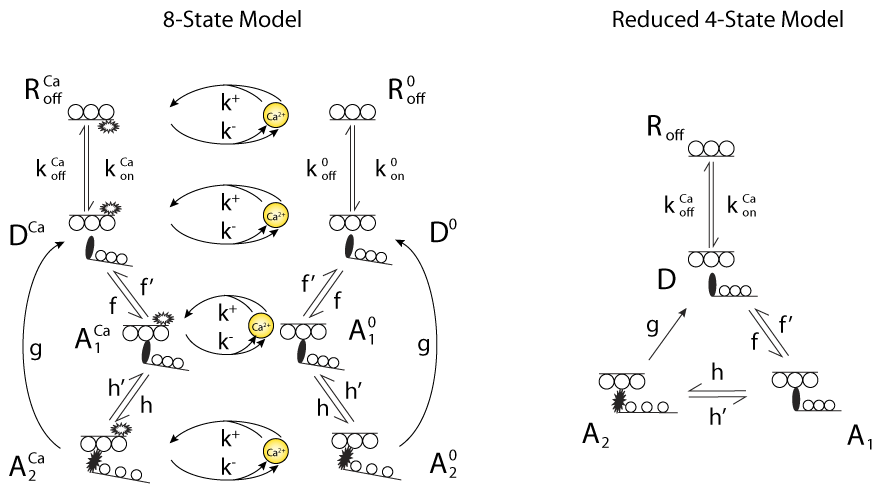Razumova, Bukatina, Campbell, 2000
Model Status
This model runs in PCEnv and COR to recreate the published results. As described in the paper, this model simulates isometric conditions and has parameters for v,w, and u set to 1. This is the condition for no cooperativity, but changing these values allows for differing degrees of cooperativity. Ca activation is maximized, to mimic Table 2 in the paper.
Model Structure
Abstract: Cooperativity in contractile behavior of myofilament systems almost assuredly arises because of interactions between neighboring sites. These interactions may be of different kinds. Tropomyosin thin-filament regulatory units may have neighbors in steric blocking positions (off) or steric permissive positions (on). The position of these neighbors influence the tendency for the regulatory unit to assume the on or off state. Likewise, the tendency of a myosin cross-bridge to achieve a force-bearing state may be influenced by whether neighboring cross-bridges are in force-bearing states. Also, a cross-bridge in the force-bearing state may influence the tendency of a regulatory unit to enter the on state. We used a mathematical model to examine the influence of each of these three kinds of neighbor interactions on the steady-state force-pCa relation and on the dynamic force redevelopment process. Each neighbor interaction was unique in its effects on maximal Ca2+-activated force, position, and symmetry of the force-pCa curve and on the Hill coefficient. Also, each neighbor interaction had a distinctive effect on the time course of force development as assessed by its rate coefficient, kdev. These diverse effects suggest that variations in all three kinds of nearest-neighbor interactions may be responsible for a wide variety of currently unexplained observations of myofilament contractile behavior..
 |
| Schematic diagram of the Razumova et al model. (Left) Eight-state cross-bridge activation and cycling model. A segment of the thin filament is represented by the chain of three circles. The thin-filament regulatory unit is represented by the bar associated with the 3-circle chain. The regulatory unit is in the on state when the bar is above the 3-circle chain and in the off state when the bar is below the chain. The myosin cross-bridge is represented by the shaded ellipse with the coiled tail. The cross-bridge may be detached (D) or attached (A1, A2) to the thin filament. In isometric conditions, force bearing is by the post-power stroke A2 state. Calcium is bound to the regulatory unit by all states on the left half of the left panel and not bound to all states on the right half of the left panel. Superscripts indicate calcium-binding status. See text for definitions and detailed explanations. (Right) Reduced 4-state representation of 8-state model. Calcium binding and dissociation is now contained within the calcium dependence of the kon(Ca) and koff(Ca) rate coefficients. |
Different Myofilament Nearest-Neighbor Interactions Have Distinctive Effects on Contractile Behavior Maria V. Razumova, Anna E. Bukatina, Kenneth B. Campbell, 2000, Biophysical Journal , 78, 3120-3137. PubMed ID: 10827989

